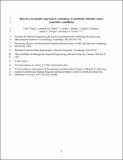Reactive metabolic byproducts contribute to antibiotic lethality under anaerobic conditions
Author(s)
Wong, Felix; Stokes, Jonathan M; Bening, Sarah C; Vidoudez, Charles; Trauger, Sunia A; Collins, James J; ... Show more Show less
Downloadpaper-v18.pdf (6.027Mb)
Publisher with Creative Commons License
Publisher with Creative Commons License
Creative Commons Attribution
Terms of use
Metadata
Show full item recordAbstract
Understanding how bactericidal antibiotics kill bacteria remains an open question. Previous work has proposed that primary drug-target corruption leads to increased energetic demands, resulting in the generation of reactive metabolic byproducts (RMBs), particularly reactive oxygen species, that contribute to antibiotic-induced cell death. Studies have challenged this hypothesis by pointing to antibiotic lethality under anaerobic conditions. Here, we show that treatment of Escherichia coli with bactericidal antibiotics under anaerobic conditions leads to changes in the intracellular concentrations of central carbon metabolites, as well as the production of RMBs, particularly reactive electrophilic species (RES). We show that antibiotic treatment results in DNA double-strand breaks and membrane damage and demonstrate that antibiotic lethality under anaerobic conditions can be decreased by RMB scavengers, which reduce RES accumulation and mitigate associated macromolecular damage. This work indicates that RMBs, generated in response to antibiotic-induced energetic demands, contribute in part to antibiotic lethality under anaerobic conditions.
Date issued
2022-09Department
Massachusetts Institute of Technology. Department of Biological EngineeringJournal
Molecular Cell
Publisher
Elsevier BV
Citation
Wong, Felix, Stokes, Jonathan M, Bening, Sarah C, Vidoudez, Charles, Trauger, Sunia A et al. 2022. "Reactive metabolic byproducts contribute to antibiotic lethality under anaerobic conditions." Molecular Cell, 82 (18).
Version: Author's final manuscript